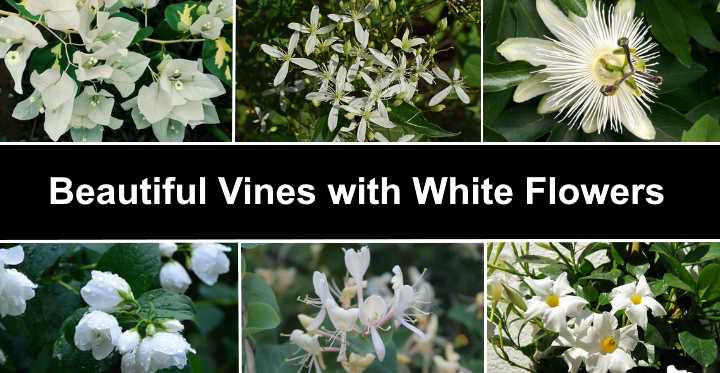Climbing or creeper plants with white blossoms are a delightful addition to any garden. These plants can climb arbors or trellises, spill over walls, hang from hanging baskets, or dangle from pergolas, adding an elegant touch. The clean white flowers provide a striking contrast against the lush green foliage.
White flowering climbing vines are typically perennial plants that come back year after year and come in a range of colors. Many of these climbers have evergreen leaves, providing year-round interest to your garden. In warm regions, white perennial vines like white jasmine, white moonvine, and white flowering clematis can bloom annually. Some hardy perennial climbers are also grown as annuals in colder regions.
This article presents a list of some of the best white flowering vines for your garden, complete with descriptions and pictures of the plants. With this information, you can choose the best white flowering climbers to enhance the beauty of your landscape.
Types of Vines for Your Garden or Yard
Choosing the right type of blooming vine is crucial to achieving the desired effect in your garden. There are two types of flowering climbing plants: climbing vines and creeper plants.
Climbing vines grow up walls or structures using suckers or roots that attach to surfaces. They are often found naturally growing up trees, buildings, and house fronts. Some climbing plants have tendrils or small shoots that wrap around thin objects.
Creeper plants, on the other hand, do not have a natural tendency for surface attachment. They spread out over the ground, cascade down walls, or dangle from the sides of containers. Hanging baskets are perfect for several kinds of creeper flowers. You can also train creeper vining plants to grow on lattice fencing or arbors by connecting or wrapping the long vines around them. Support can also be provided for these plants.
Where to Plant Flowering Vines
White-flowered blooming vines can be great additions to a garden, and they thrive in full sun or partial shade. They can enhance garden landscaping elements like arbors, trellises, pergolas, and walls while also serving as natural screens. Here are some tips for planting white blooming vines in your garden:
Climbing vines: These plants attach themselves to buildings, brick walls, and wooden structures. Climbing plants with white flowers like climbing hydrangea, trumpet vine, and sweet autumn clematis are ideal for covering house facades and for use as living boundaries. Their little clinging shoots can create a wall of white summer flowers and green foliage around chicken wire, lattice frames, and chain links.
Creeper plants: Several types of creeping vines can be used as ground cover in sunny gardens. They can quickly cover exposed soil and produce white flowers from spring to the end of summer. Some of the best white creeping vines include white creeping thyme, white vinca, and white alyssum.
The Best White Flowering Vines (With Pictures)
Let’s take a closer look at the most exquisite white blooms on vining vines. The flowers’ characteristics and photographs may help you identify the vines. There are also helpful instructions for growing vines in your own yard.
White Flowering Clematis Vines (Clematis armandii, Clematis paniculata)
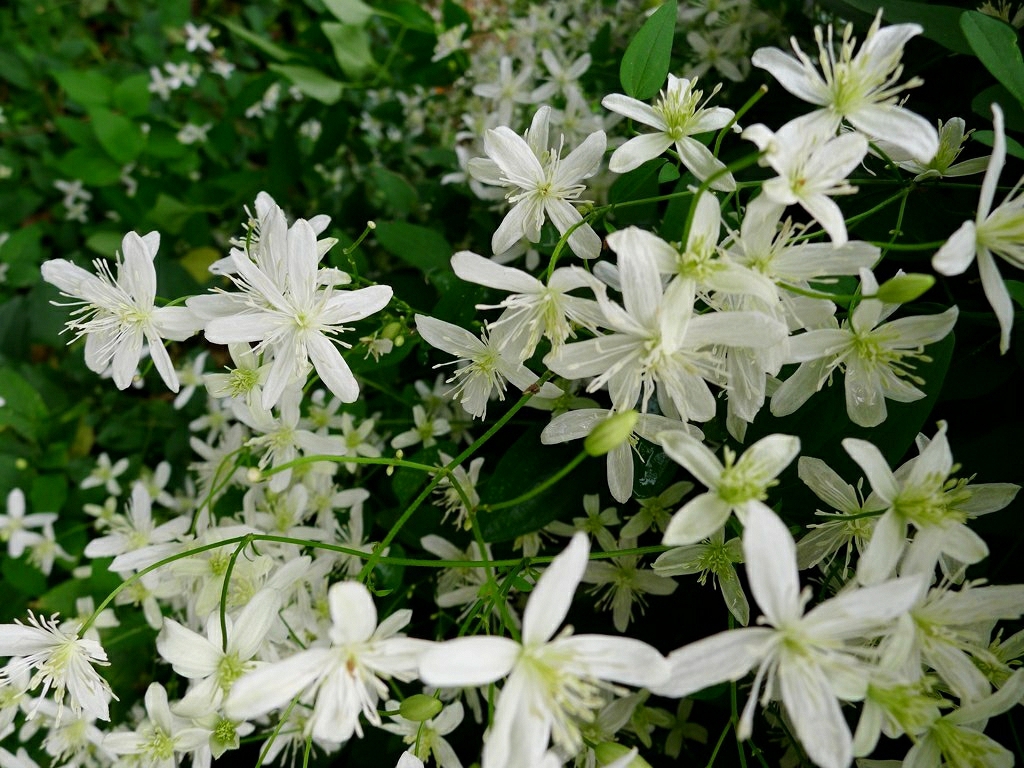
The white clematis is a climbing plant that bears huge, fragrant, star-shaped white flowers and dark green leaves that can be evergreen or deciduous. These showy white blooms appear from late winter to early spring and measure 1″ to 3″ (2.5 – 7 cm) wide.

Clematis Paniculata vines reach a height of 15 to 30 feet (4.5 to 9 m) and width of 10 to 15 feet (3 to 4.5 m). In USDA zones 7 through 9, Clematis are twining perennial vines that grow as evergreen plants in full sun to part shade. The perennial vines bloom early in the spring in colder climes when the foliage has died off.
White Flowering Honeysuckle Vine (Lonicera albiflora)
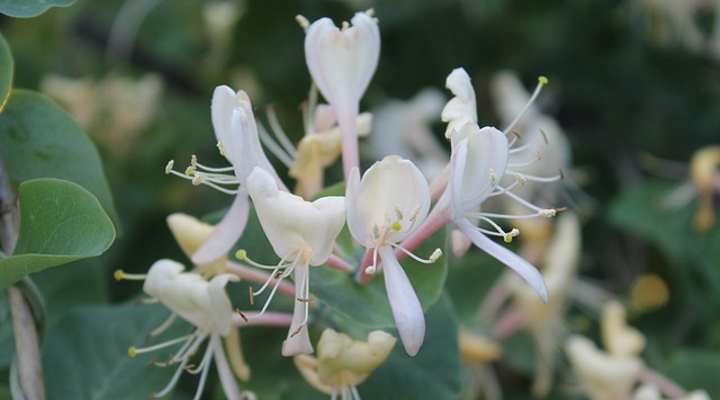
White honeysuckle is a vining plant that produces fragrant, creamy-white flowers with curling petals. The plant has oval-shaped grayish-green leaves and thrives in both full sun and partial shade. The gorgeous blooms attract pollinators from spring through summer and release fragrant nectar.
The cluster of 2″ to 3″ (5 – 7.5 cm) long flowers are white or yellow and white and grow at the ends of the branches. White honeysuckle can grow up to 3 to 10 feet (1 to 3 m) tall and broad and can be trained to climb over pergolas, trellises, walls, and fences in full sun. It is a drought-tolerant perennial vining plant that is easy to grow.
Climbing White Jasmine (Jasminum officinale)
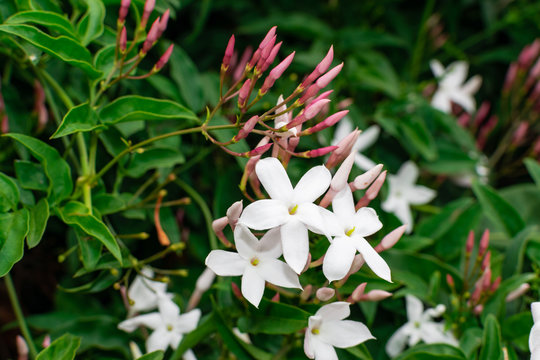
White jasmine is a highly fragrant climbing vine that features small clusters of white scented flowers and green leaves. These sweet-smelling blooms give off a pleasant scent that lingers throughout the summer months. Each cluster of flowers comprises three to five blooms, each measuring 1 inch (2.5 cm) in diameter.
Also known as summer jasmine, common white jasmine, or true jasmine, this spreading shrub can grow up to 15-30 feet (4.5-9 meters) tall and 7-15 feet (2.1-4.5 meters) wide. It is a woody perennial vine that thrives in full sun or partial shade and is best suited for USDA zones 7 through 10. White jasmine is a great option for creating a living barrier and can be grown over arbors or in a container garden. It can also be cultivated as a perennial ground cover or creeper vine.
White Mandevilla Vine (Mandevilla boliviensis)

White Mandevilla is a tropical vine with glossy green leaves, trailing stems, and white funnel-shaped flowers. It thrives in full sun and warm temperatures. The vine’s flowers have five pointed lobes that are 2″ to 3″ (5 – 7.5 cm) wide, with a yellow center that adds to its beauty.
When allowed to grow as a vine, White Mandevilla can reach a height of 12 feet (3.5 meters) and a width of 6 feet (1.8 meters). It can be trained to climb up trellises, arbors, pergolas, or poles, or can be grown in hanging baskets. In colder climates, White Mandevilla can be grown as an annual container plant.
White Bougainvillea Vine

Bougainvillea is a stunning tropical vining plant with a woody stem that produces a profusion of bright flowers during summer, and is available in different colors. This climbing vine bears small tubular blooms arranged in clusters of three. The flowers are surrounded by pink, red, orange, yellow, or white bracts.
Bougainvillea is an evergreen climbing vine that thrives in USDA zones 9 and 10. The leafy foliage is densely grown on spreading stems that grow up to 40 feet (12 meters) in height and width. In colder climates, Bougainvillea is grown as an annual. It has white, pink, purple, red, or orange flowers and looks fantastic in hanging baskets with its leafy stems cascading down.
White Wisteria Vine (Wisteria floribunda ‘Alba’)
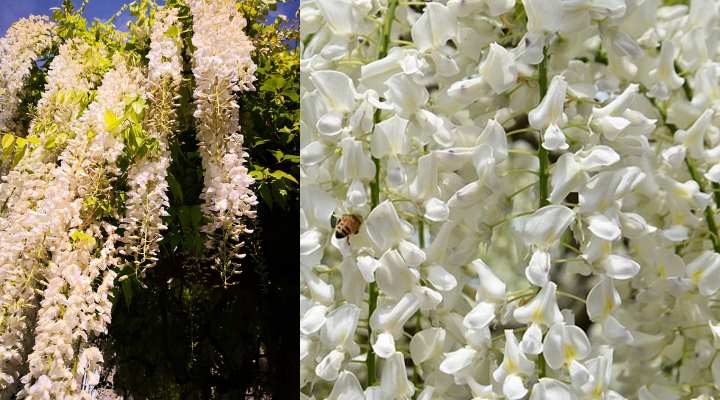
White Japanese wisteria is a stunning climbing plant with lime-green pinnate leaves and clusters of tiny tubular white fragrant blooms that drape gracefully over arbors or pergolas. The hanging white flower clusters of the woody vine may grow up to 24 inches (60 cm) long and bloom in late spring and early summer.
The white-flowered Japanese wisteria is suitable for USDA zones 5 to 9. The woody stems of the climbing plant can grow up to 30 feet (9 meters) tall and 20 feet (6 meters) wide in full sun. The twining stems spiral around their support to attach themselves. White wisteria vines can be trained to grow over pergolas, trellises, and arbors. Additionally, the shrub-like climbing plant can be grown as a standalone ornamental container plant or trained to grow against a house wall.
White Flowering Corkscrew Vine (Vigna caracalla)
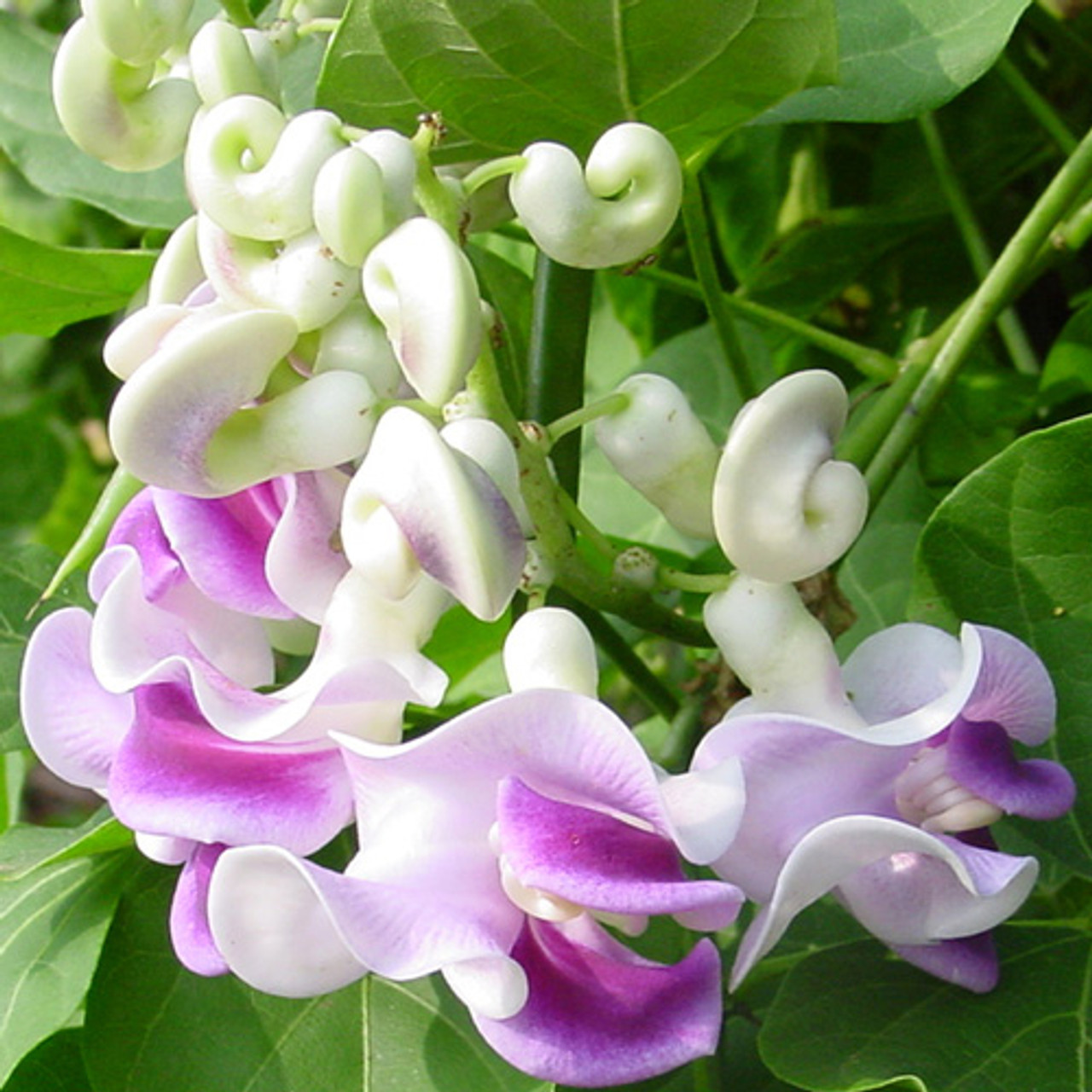
The corkscrew vine is a perennial climber with spiral-shaped white flowers that give it a unique and distinctive appearance. The flowers are creamy-white, 2 inches (5 cm) long, and have traces of purple and blue hues. The blooms grow in clusters and are up to 12 inches (30 cm) long.
The corkscrew vine blooms from mid-summer to frost, and it is evergreen in USDA zones 9 to 12. In colder areas, it loses its palmate green leaves. The vine prefers partial to full sun and is commonly grown on trellises or over fences and walls. In frost-free regions, it can be grown in containers to overwinter the shrub-like vine. The spreading vines can grow up to 30 feet (9 meters) tall and 6 feet (1.8 meters) wide.
Climbing Hydrangea (Hydrangea anomala)

Climbing hydrangeas are deciduous, fast-growing plants that can climb up walls, fences, and pergolas with flattened clusters of creamy-white flowers and large, glossy dark-green leaves. The white lacecap hydrangea blooms throughout spring and summer while the leaves turn to rich golden colors in autumn, and the reddish bark adds winter appeal. It is cold-hardy and perfect for USDA zones 4 to 9, thriving in full sun or partial shade.
Depending on the variety, the plant may grow between 30 to 40 feet (9 to 12 meters) tall and broad. It looks stunning growing against a home wall or tall fence when supported, and it’s also perfect for climbing arbors, pergolas, or growing around the trunks of big trees.
White Trailing Fuchsia Vine (Fuchsia x hybrid)
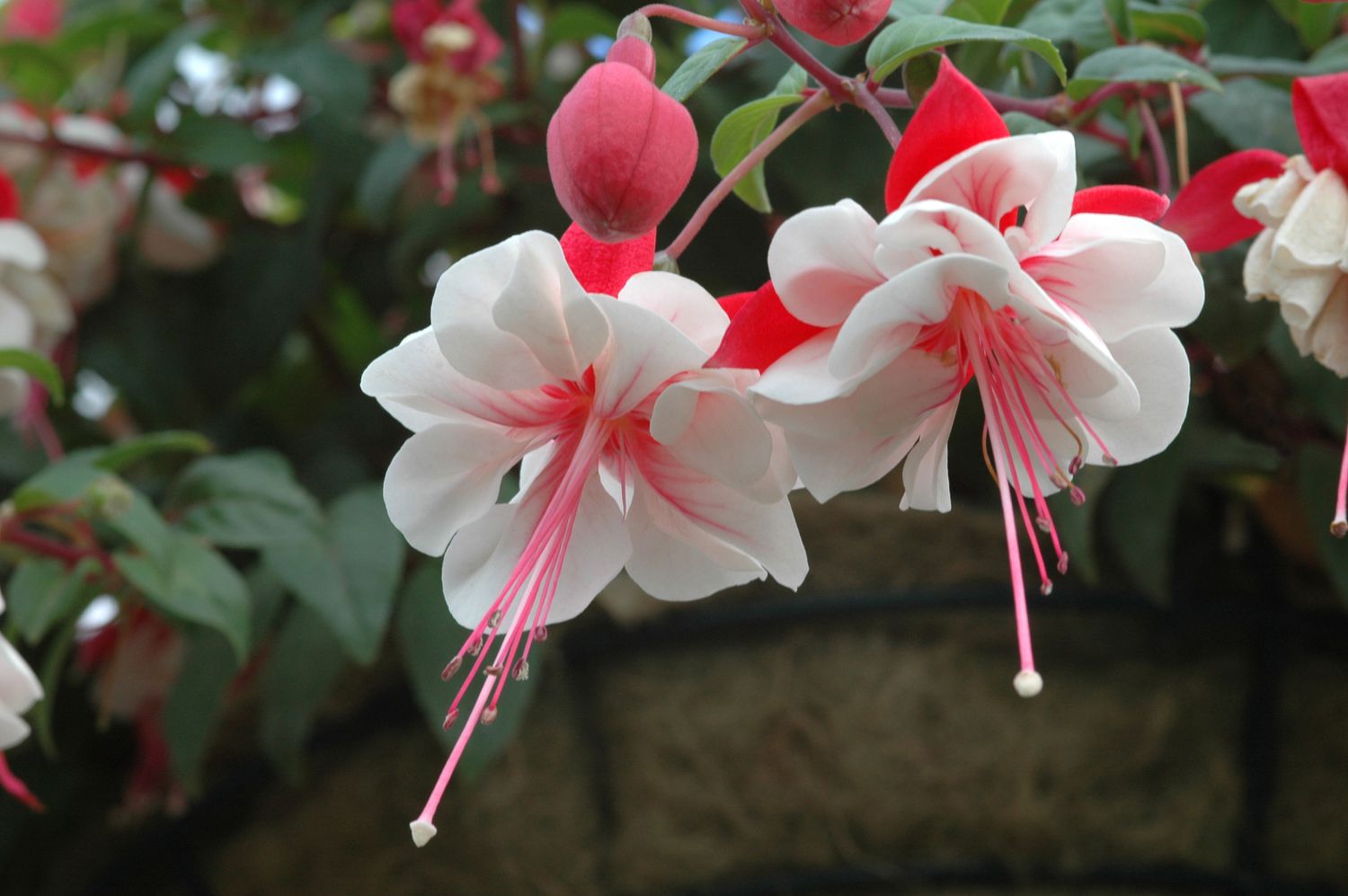
White fuchsia plants produce stunning blooms that are white with a pink tint, giving them a romantic and elegant look. These fast-growing climbing plants produce small clusters of tubular flowers with four or five overlapping petals and protruding stamens at the center. Fuchsia plants come in various colors such as white, red, purple, and pink.
Fuchsia plants should be grown in full shade in USDA zones 10 to 12, and they are often grown in hanging baskets or summer container gardens. They have long dangling stems and are intolerant of cold temperatures. Fuchsia plants are perfect for displaying on patios and decks during the summer season.
White Trumpet Vine (Thunbergia grandiflora ‘Alba’)
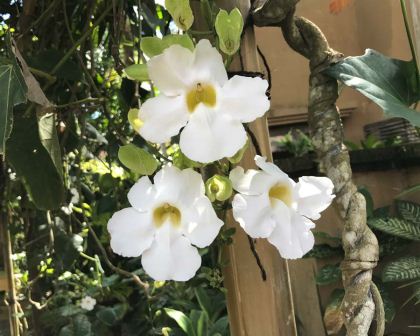
White trumpet vines are hardy climbers that grow well in sunny locations. They are evergreen and produce large trumpet-shaped flowers in abundance throughout the summer and into the fall. These flowers, which are up to 7.5 cm (3 inches) wide, give the plant its name. The white blossoms have yellow centers, making them very attractive.
The vines have rope-like stems that twine around and cling to buildings. They also produce large, dark-green lanceolate leaves that can grow up to 5 inches (13 cm) long. In USDA zones 4-9, white trumpet vines can grow up to 15 to 30 feet (4.5 to 9 meters) tall. To get the best results, plant them in a sunny location in your garden.
White Moonvine (Ipomoea alba)
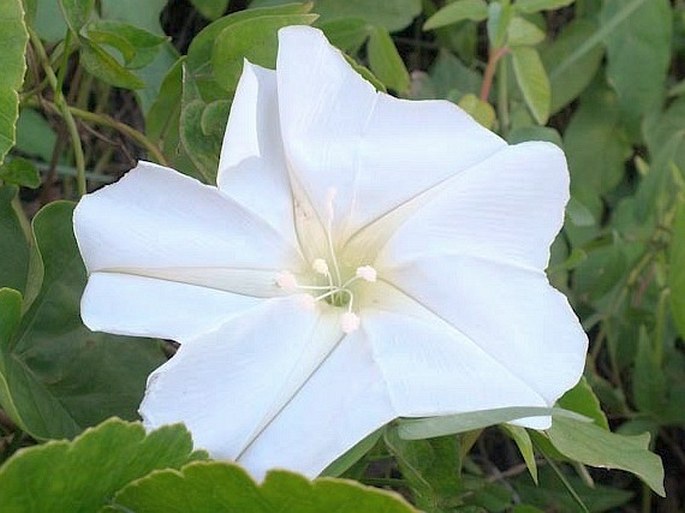
White moonvine is a rapidly growing perennial vine that produces white, 5-petaled flowers and heart-shaped green leaves. This blooming vine is known for its large, funnel-shaped blossoms that bloom at night, which is how it got the name “white moonvine.” These flowers can be up to 6 inches (15 cm) wide, and they are simply stunning.
White moonvine thrives in full sun and is best suited for USDA zones 10-12. For colder regions, it can be grown as an annual or kept indoors during the winter months. This twining vine can be grown on a trellis, arbor, or fence as a tender perennial, and it can also be grown in hanging baskets, container gardens, or pots. White moonvine climbers can grow up to 10-15 feet (3-4.5 meters) tall and have a width of up to 6 feet (1.8 meters).
White Morning Glory (Ipomoea pandurata)
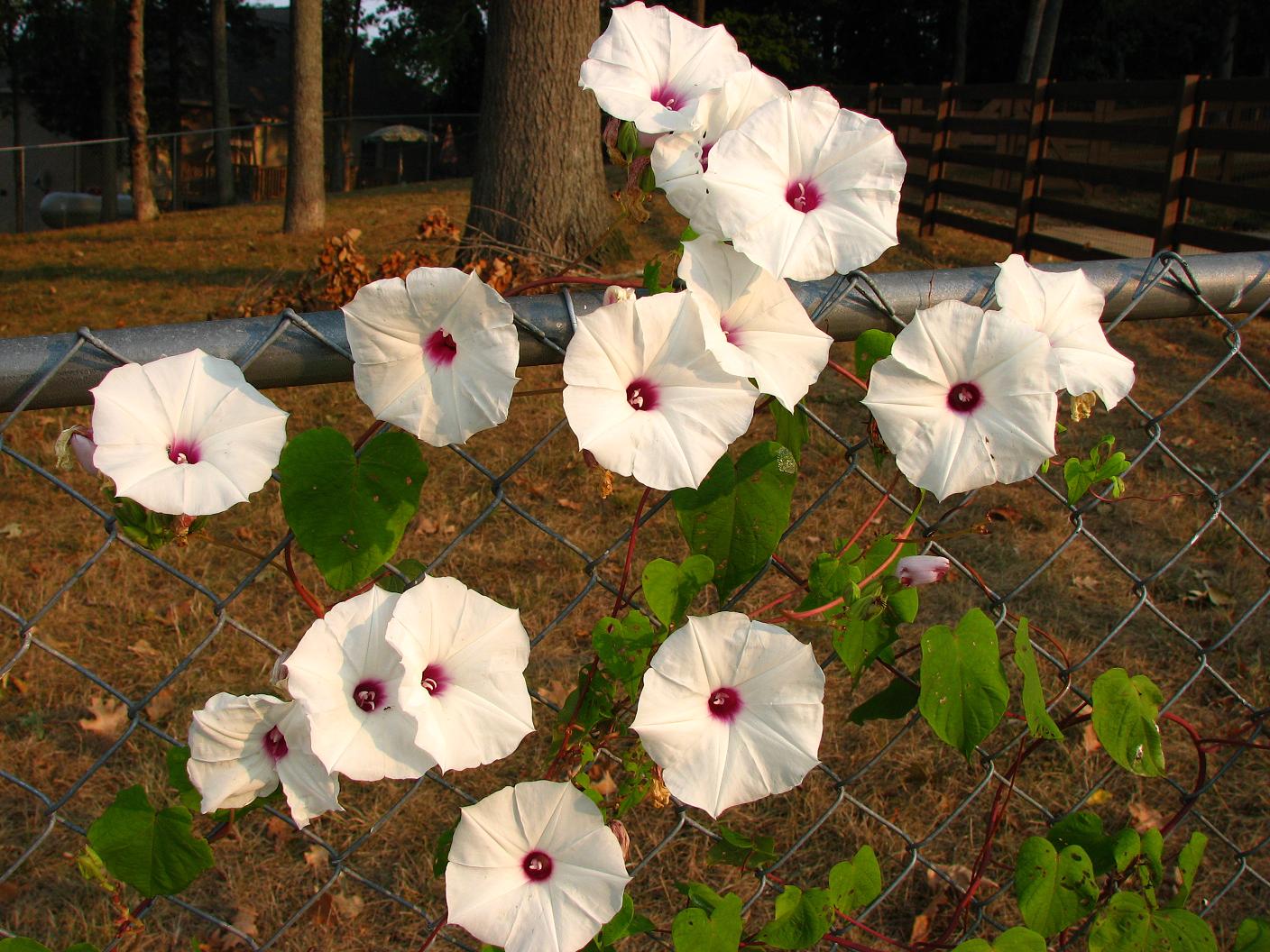
The white morning glory is a fast-growing deciduous vine that spreads quickly. It produces beautiful disc-shaped white flowers with crimson centers along the tendril vining stems. The vine blooms from spring to fall, allowing you to enjoy the funnel-like flowers for a long time. The white flowers are up to 3 inches (7.5 cm) wide and look stunning against the heart-shaped leaves.
The white morning glory thrives in USDA zones 6 to 8 and requires full sun or partial shade to produce an abundance of pure white blooms. The climbing plant can reach a height of 15 to 30 feet (4.5 to 9 meters) and a width of up to 6 feet (1.8 meters). Pergolas, arbors, and living fences are perfect for this spreading vine. If you don’t provide any support, you can let the rich foliage grow as flowering ground cover.
White Climbing Roses (Rosa)

White climbing roses are large and sprawling shrubs that can climb over trellises, walls, fences, or doors. They come in various shapes and sizes, and during the summer, they produce stunning flower displays. Climbing roses can have showy double blooms, clusters of small single blooms, or large ruffled pom-pom blooms in beautiful white shades.
It’s best to provide support for the arcing canes of ornamental climbing roses as they can grow up to 15 feet (4.5 meters) tall with proper care. Poles, arches, pergolas, walls, or the front of a house can all be used to grow climbing roses. In USDA zones 5 to 9, these decorative roses can be planted in the ground or in pots, and they should be provided with enough water in the summer to bloom well.
White Passionflower Climbing Vine (Passiflora)

The white passionflower climbing vine produces stunning snow-white blooms that grow in full sun. The flowers have longer petals and thin pointed filaments, measuring up to 5 inches (13 cm) in diameter. The vine also features dark green pointed oblong leaves that beautifully contrast the white flowers.
Passiflora, the semi-evergreen climbing vine, thrives in USDA zones 6 to 9, and grows up to 10 to 20 feet (3 to 6 meters) tall. The fast-growing vine blooms continuously throughout summer and autumn. The fragrant white flowers make trellises, arbors, walls, and fences more attractive. The spreading vines can also climb brickwork and stone walls to add more appeal to outdoor spaces.
White Sweet Pea (Lathyrus odoratus)

White sweet pea vines are fast-growing annual climbers that thrive in full sun. The small, delicate white flowers have connected petals that are 1″ to 3″ (2.5 to 7.5 cm) wide. Sweet pea vines are also available in a variety of other colors, including crimson, lilac, peach, and purple. To ensure continued bloom throughout the season, it is recommended to deadhead the blooms regularly.
If you live in zone 5, you should start sweet pea seeds indoors about eight weeks before the last frost date. In zones 7 and 8, sweet pea seeds may be planted in the fall and will bloom in early spring. In just one year, sweet pea climbers can grow up to 6 feet (1.8 meters) tall and 1 foot (30 millimeters) wide. Sweet pea vines can be cultivated in USDA zones.
